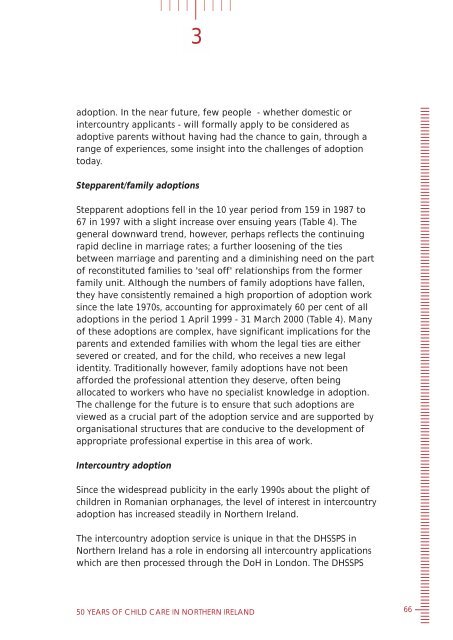childcare-50years
childcare-50years
childcare-50years
You also want an ePaper? Increase the reach of your titles
YUMPU automatically turns print PDFs into web optimized ePapers that Google loves.
adoption. In the near future, few people - whether domestic or<br />
intercountry applicants - will formally apply to be considered as<br />
adoptive parents without having had the chance to gain, through a<br />
range of experiences, some insight into the challenges of adoption<br />
today.<br />
Stepparent/family adoptions<br />
Stepparent adoptions fell in the 10 year period from 159 in 1987 to<br />
67 in 1997 with a slight increase over ensuing years (Table 4). The<br />
general downward trend, however, perhaps reflects the continuing<br />
rapid decline in marriage rates; a further loosening of the ties<br />
between marriage and parenting and a diminishing need on the part<br />
of reconstituted families to 'seal off' relationships from the former<br />
family unit. Although the numbers of family adoptions have fallen,<br />
they have consistently remained a high proportion of adoption work<br />
since the late 1970s, accounting for approximately 60 per cent of all<br />
adoptions in the period 1 April 1999 - 31 March 2000 (Table 4). Many<br />
of these adoptions are complex, have significant implications for the<br />
parents and extended families with whom the legal ties are either<br />
severed or created, and for the child, who receives a new legal<br />
identity. Traditionally however, family adoptions have not been<br />
afforded the professional attention they deserve, often being<br />
allocated to workers who have no specialist knowledge in adoption.<br />
The challenge for the future is to ensure that such adoptions are<br />
viewed as a crucial part of the adoption service and are supported by<br />
organisational structures that are conducive to the development of<br />
appropriate professional expertise in this area of work.<br />
Intercountry adoption<br />
3<br />
Since the widespread publicity in the early 1990s about the plight of<br />
children in Romanian orphanages, the level of interest in intercountry<br />
adoption has increased steadily in Northern Ireland.<br />
The intercountry adoption service is unique in that the DHSSPS in<br />
Northern Ireland has a role in endorsing all intercountry applications<br />
which are then processed through the DoH in London. The DHSSPS<br />
50 YEARS OF CHILD CARE IN NORTHERN IRELAND<br />
66


